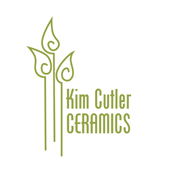





I am fortunate to be able to work in Worcester, Massachusetts in the winter and the Finger Lakes in the summer. Each location has its advantage: Worcester has the larger kiln and all the glaze materials. Keuka Lake offers the larger space to work in and an inspiring view of the water.
In both places, I do throw pots but I make more pieces handbuilding with slabs. I became a handbuilder because I got tired of "round" and enjoy the geometric exercise of designing pots in pieces. I envision what I want to make, and then work out the proportions and design by drawing on the computer and using trial and error. Once I am happy with the form, I make a pattern using oak tag. This allows me to make the pot as many times as I want (which may not be too often because I get bored with lots of repetition.)
While the pot is in pieces and not yet leather hard, I apply surface decoration using a variety of methods. Sometimes I press homemade stamps, natural materials, or commercial texture mats into the clay. Other times I use tyvek stencils that I have cut and paint slips on the clay. I also carve and attach sprigs to the surface. I try to keep clean hands to avoid smudging the surface designs when I assemble the pot.
After the pots are bisqued, I may add Chinese transfers (which I call "tattoos") or paint areas with underglaze paints. I am finding my way with the latter process.
Of course, the final task is to glaze the piece, my least favorite part of making pottery. Never having majored in ceramics, developing a glaze palette has been a challenge. I have begged, borrowed, and stolen recipes and used the expertise of the faculty at the Worcester Center for Crafts and anyone else I can find to advise me when I get in trouble. I currently find myself with about 7-8 glazes that I like. I apply them mostly by dipping and I use latex or wax resist when I want two or more glazes on a pot. Then the electric kiln gods take over and I hold my breath until the glaze firing is done.
The "rocking box" to the left illustrates my working method. First I cut the pieces using a pattern and an xacto knife. Next I used a tyvek stencil and brushed black slip over each of four sides. I assembed the box by mitering, slipping and scoring the edges. After the box was bisqued, it was glazed in "frosty slate" and "satin black".

